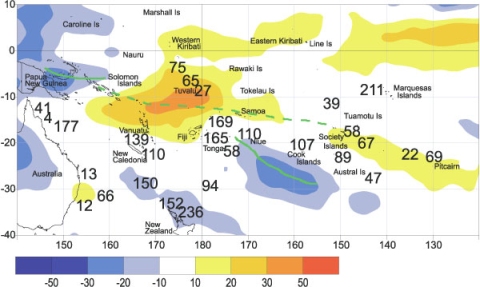Climate developments in May 2004
Suppressed convection and below average rainfall predominated over a large region of the Southwest Pacific about and west of the Date Line, from Vanuatu to Samoa, including Fiji (where it was very dry and sunny in the west of the main island) and Tuvalu. Suppressed convection and below average rainfall also occurred over much of the central of southern French Polynesia across to Pitcairn Island, and along the Equator about and east of Eastern Kiribati. May rainfall was less than 75% of average over much of central French Polynesia and Pitcairn Island, and less than 50% over average in parts of Fiji, Tuvalu, and Vanuatu.
Enhanced convection and above average rainfall occurred over Northern Australia, parts of Indonesia, the Caroline Islands, and Papua New Guinea. The SPCZ (South Pacific Convergence Zone) was largely confined about and west of the Date Line during May.
However, a region of active convection did occur east of the Date Line, from about Niue to the region south of the Southern Cook and Austral Islands. Rainfall was at least 200% of normal in the Marquesas Islands, and at least 125% of normal in parts of New Caledonia and Tonga. New Caledonia’s May rainfall anomaly was due to a single high 1-day rainfall event (over 200 mm in some areas). May rainfall was also above average in northern New Zealand.
There have now been 5 consecutive months with above average rainfall in the Marquesas Islands.
Mean air temperatures were 1.0°C above average in the Southern Cook Islands, and about 0.5°C above average in southern Tonga and Samoa. Below average mean temperatures occurred in Vanuatu.
Tropical Southwest Pacific mean sea-level pressures continued above average west of the Date Line, and below average in the equatorial east. They were well above average however, in Southern French Polynesia.
Climate extremes in May 2004
| Country | Location | Rainfall (mm) | % of average | Comments |
|---|---|---|---|---|
| Australia | Townsville Airport | 1 | 4 | Extremely low |
| Tuvalu | Nuilakita Island | 63 | 27 | Record low |
| French Polynesia | Gambier, Rikitea | 34 | 22 | Record low |
| Country | Location | Mean Temp (°C) | Dep. (°C) | Comments |
|---|---|---|---|---|
| Fiji | Laucala Bay | 26.5 | Record high | |
| Fiji | Navua | 24.8 | Record high |

